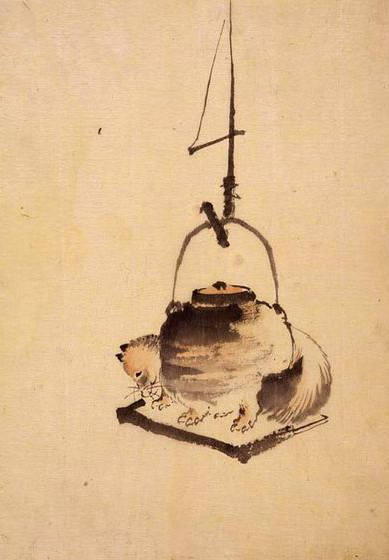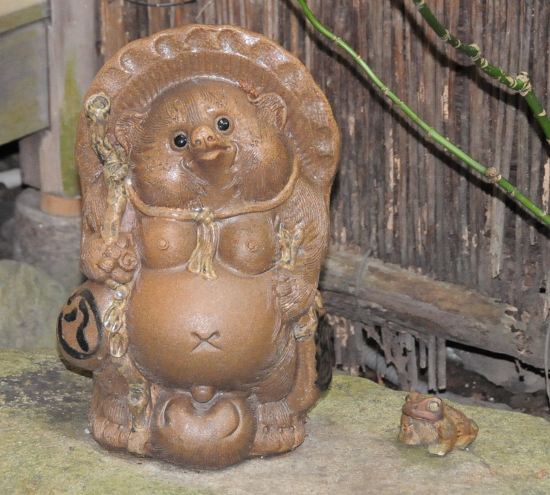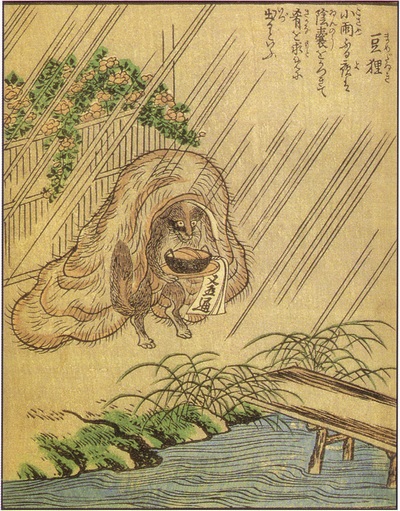One of the most ubiquitous creatures that can be found all over Japan is the tanuki. Statues of the tanuki – translated as raccoon dog – are often seen outside restaurants or shops to beckon customers, just like the Japanese maneki neko cat. Unlike the maneki neko, however, tanuki can also be found at entrances to private homes or around the precincts of Buddhist temples. They are also the subject of many woodblock prints from the Edo period, and they feature in numerous stories, the oldest ones dating back to the 8th century.
 Long before that, tanuki were revered as gods or at least godlike creatures, who ruled over Japanese nature. However, that changed with the introduction of Buddhism and tanuki were relegated to divine messengers and local guardian spirits. They are still seen as magical today, mostly as pranksters and mischievous little beasts, who, even though they may mean no harm, can wreak havoc to the minds and bodies of their unsuspecting victims.
Long before that, tanuki were revered as gods or at least godlike creatures, who ruled over Japanese nature. However, that changed with the introduction of Buddhism and tanuki were relegated to divine messengers and local guardian spirits. They are still seen as magical today, mostly as pranksters and mischievous little beasts, who, even though they may mean no harm, can wreak havoc to the minds and bodies of their unsuspecting victims.
The most amazing feat any tanuki can perform is shapeshifting. Shapeshifting into anything, really: stones, trees, statues, things as extraordinary as the moon and as common as household items… There is a cute story about the latter: A tanuki wanted to repay a farmer for a good deed and transformed into a beautiful tea kettle, which the farmer sold for a good price to a rich man. But the first time the tea kettle was put to use and heated over a fire it sprouted head, tail, and legs, and returned to the farmer. In the end, the farmer earned a lot of money for showing people the tailed and snouted tea kettle, so there is a good ending to the story after all.
 Tanuki also enjoy taking human form, in particular that of Buddhist monks, in which they received the special name of tanuki-bozu. In this shape, they are out to cause mischief by imitating – more or less perfectly – human activities like attending funerals, or working as a scribe. Of course, sooner or later the disguise will be discovered and the poor tanuki is thrown out of the temple, but there is one legend of a tanuki-bozu that was allowed to become a page at the temple after his discovery, and was even buried in a regular grave. Most of the times such a favourable treatment is not the case though, and the tanuki must leave, which means that all the things he has bewitched during his stay – something else they are capable of – will return to their real shape, piles of money will then turn to leaves, for example.
Tanuki also enjoy taking human form, in particular that of Buddhist monks, in which they received the special name of tanuki-bozu. In this shape, they are out to cause mischief by imitating – more or less perfectly – human activities like attending funerals, or working as a scribe. Of course, sooner or later the disguise will be discovered and the poor tanuki is thrown out of the temple, but there is one legend of a tanuki-bozu that was allowed to become a page at the temple after his discovery, and was even buried in a regular grave. Most of the times such a favourable treatment is not the case though, and the tanuki must leave, which means that all the things he has bewitched during his stay – something else they are capable of – will return to their real shape, piles of money will then turn to leaves, for example.
As mentioned above, statues of tanuki can be found all over Japan, and although they come in various sizes, they all essentially look the same. The reason for this is, that these statues go back to a single artist called Tetsuzo Fujiwara, a potter who lived in Koga, a village in Shiga prefecture, that one day was visited by emperor Hirohito. Since Koga is known for pottery, the streets were lined with tanuki statues waving flags and the emperor was so amused by this, that the wrote a poem about it – and the rest is history.
 Since tanuki have been ascribed with eight special traits supposed to bring good fortune, many of the statues depict at least some of them:
Since tanuki have been ascribed with eight special traits supposed to bring good fortune, many of the statues depict at least some of them:
- friendly smile
- hat (protecting against bad fortune and weather)
- big eyes (help making good decisions and perceive the environment)
- sake bottle (representing virtue, often with the kanji for 8 written on them)
- big tail (strength and steadiness until one is successful)
- promissory note (representing trust or confidence)
- big belly (stands for decisiveness)
- big scrotum (symbolising luck in money matters)
Especially the final trait may seem a bit odd, and indeed, the origin story behind it is quite interesting. In fact, tanuki are real animals, properly translated as Japanese raccoon dogs. Sometimes, the word tanuki is falsely translated into English as badger or raccoon, but those are different species. The mistake is not surprising, because even within Japan, there are differences in naming the animal; even though tanuki is the official name, mujina is a regional variation. The confusion goes back to the kanji, which originally mostly referred to wild cats. But since there are no wild cats native to Japan (other than in Okinawa), the kanji began to be used for the tanuki. Tanuki are widespread in Japan. They live mostly in forested areas, but have also been seen scavenging in cities even as large as Tokyo.
 Anyway, back to the scrotum: Real tanuki already have a large scrotum, but this alone would probably not be enough for comic depiction. The background here is that in the old days, metal workers in Kanazawa who were charged with producing gold leaf, put their gold nuggets into the skin of tanuki scrotums before hammering. It happens that this skin in particular can be stretched extremely thin – allegedly to the size of eight tatami mats – which makes it very useful for producing gold leaf. Moreover, tanuki scrotums were made into wallets, and surely the connection between kin no tama – small gold balls – and kintama – slang for testicles – helped the legend along quite a bit as well.
Anyway, back to the scrotum: Real tanuki already have a large scrotum, but this alone would probably not be enough for comic depiction. The background here is that in the old days, metal workers in Kanazawa who were charged with producing gold leaf, put their gold nuggets into the skin of tanuki scrotums before hammering. It happens that this skin in particular can be stretched extremely thin – allegedly to the size of eight tatami mats – which makes it very useful for producing gold leaf. Moreover, tanuki scrotums were made into wallets, and surely the connection between kin no tama – small gold balls – and kintama – slang for testicles – helped the legend along quite a bit as well.
 There are many stories about tanuki and their mischievous behaviour, but not many of them involve their kintama. This particular trait was picked up by ukiyo-e artists of the Edo period. There, tanuki are depicted using their scrotums as sails for boats or even boats themselves, as fishing nets, umbrellas, cloaks… Nowadays these depictions are rare, but the statues are still very popular throughout Japan, and the tanuki also functions as mascot for a number of Japanese companies. And who knows, maybe that jolly old Japanese you just met is nothing but a tanuki in disguise waiting to make a fool of you…
There are many stories about tanuki and their mischievous behaviour, but not many of them involve their kintama. This particular trait was picked up by ukiyo-e artists of the Edo period. There, tanuki are depicted using their scrotums as sails for boats or even boats themselves, as fishing nets, umbrellas, cloaks… Nowadays these depictions are rare, but the statues are still very popular throughout Japan, and the tanuki also functions as mascot for a number of Japanese companies. And who knows, maybe that jolly old Japanese you just met is nothing but a tanuki in disguise waiting to make a fool of you…
